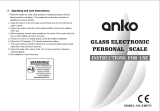13
seconds later U11 will time-out and cause the circuit power to switch off. The model 5102 has a jumper added at
location J7; this causes U11 to reset U10 in the event of a hardware/software failure.
Resistors R1, R2, R3, R5 and R14 are included for proper circuit biasing. Capacitor C6 is used as an output filter.
VOLTAGE REGULATION
Voltage regulators VR1 and VR2 render regulated sources of +5 Volts DC for operation of the analog (VAA) and digital
(VCC) circuits, respectively. Use of two separate +5V regulators helps to prevent noisy digital signals from entering
the sensitive analog circuits. Capacitors C3 and C8 are used to insure regulator stability.
+9.5V/-7.5V SUPPLY
Integrated circuit U2 is used to convert +5 Volts DC to +9.5V and -7.5 Volts DC for use in the analog circuits. It contains
an internal oscillator (operating at approximately 8 KHz) and a series of switches. During one half of the cycle
capacitor C25 is connected between VAA and ground, charging C25 to VAA’s potential of +5 Volts. During the other
half cycle capacitor C25 is reconnected between the VAA and pin 8 (negative lead of C25 to VAA) so that its voltage
adds to VAA and charges filter capacitor C26 to approximately twice VAA or 9.5 to 10 volts.
The remainder of U2 is used to generate a negative supply voltage. Capacitor C28 is connected between ground and
the +9.5 Volt source on pin 8 during one half cycle of the internal oscillator. During the other half cycle, it is
reconnected between ground and pin 4 such that its negative lead is connected to pin 4. This produces a negative
voltage. Diodes Cr8 and CR9 reduce the voltage slightly to obtain the desired -7.5 volts.
BATTERY MONITOR
Integrated circuit U3 is included to monitor the voltage of the battery and provide an indication to the scale’s
operator when battery replacement is required. Two states of weak battery operation are detected; “low-battery”
(battery is usable but will soon need replacing” and “low-low battery” (battery is too weak to properly operate the
scale.)
Pins 1, 2 and 3 of U3 are connected to a voltage divider network consisting of R8, R9 and R10, to form the “low-
battery” detector. The output of this circuit (pin 1) is normally low when the battery is good and switches high when
the battery is low. It is coupled to the busy signal of U6 (pin 21) through resistor R36 to the driver for the front panel
“LO BATT” indicator. This causes the “LO BATT” indicator to flash when the battery is low.
The remaining half of U3, pins 5, 6 and 7, are connected to resistors R11, R12 and R13 to form the “low-low” battery”
detector. The output on pin 7, which is normally “high” with a good battery, goes “low” when the battery is too
weak to reliably operate the scale. This output is connected to an I/O pin on microcomputer U10 to signal the
microcomputer the “low-low” battery has been recognized. The microcomputer U10 will process the “low-low”
battery signal and cause “bAttrY” to appear on the scale’s front panel display, in addition to the flashing “LO BATT”
annunciator.
MICROCOMPUTER AND SUPPORT CIRCUITS
To attain various additional features such as automatic zero tare, pounds/kilograms conversion, weight lock-in,
previous weight memory, etc., a microcomputer is employed to additionally process the data supplied by the A/D
converter. This microcomputer system consists of U10, a microcomputer; U7, a peripheral port expander to furnish
additional input/output lines; U9, a non-volatile memory which stores the previous weight reading; and U11 (23005
R02 only), a device to generate reset conditions for the microcomputer.
During operation of the scale the microcomputer continually receives the weight readings from the A/D converter.
This data is received in a “multiplexed” format (one digit at a time) from the output of the A/D converter




























